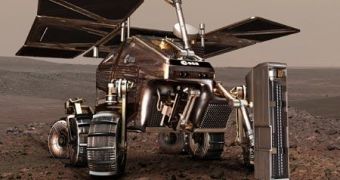Is there, or has there ever been life on Mars? Well, we've been studying Mars for nearly four decades and the answer is nowhere to be found. Simply put, there is no direct proof of life on the Red Planet but neither is there evidence to exclude such possibility. The ESA on the other hand plans to put an end to this question once and for all by launching in 2013 the ExoMars mission, which will carry an instrument able to establish whether biological activity was ever possible for Mars.
NASA is already expressing interest in ESA's mission and has recently allocated 2 million US dollars in support. The device, called the Urey instrument, named after Harold Urey, the man who showed that amino acids could have been produced in Earth's early atmosphere, will have as primary objective the search for amino acids. Once the amino acids are found, the Urey instrument should be able to tell the difference between L and D amino acids.
The notation L and D signifies the 'chirality' of the amino acid, or the kind of mirror-image configuration the amino acid is expressing. "Life on Earth is based on chiral molecules, so our underlying assumption is that is a central feature of biochemistry", explains instrument team leader Jeffrey Bada from the University of California.
Life originating on a particular planet is expected to show one of the two chiral forms, either L or D. On Earth for example, all amino acids bear L form. The Urey instrument will separate different chemicals through electrophoresis processes, by exploiting the fact that ions move at different speeds while being placed inside an electric field.
Distinction between the two amino acid chiral forms is made during the reaction with another chiral molecule, g-cyclodextrin. "We're down to the level of being able to detect a few cells per gram", says Bada. Not even NASA's Phoenix Mars spacecraft, expected to land on the Red Planet by the end of this month, is able to detect such small amounts of organic matter.
However, there is a small problem. "If we find L acids, then things get more complicated." It may turn out that both Earth and Mars chose the L acids independently, "or it may imply we're related in some way, that microbes from Earth seeded Mars, or vice versa", says Bada.
Because the upper layers of the soil would have destroyed all signs of organic matter, the Urey instrument will have to be able to drill as much as 2 meters beneath the Martian surface in order to extract any organic molecules. Chemical processes are able to modify amino acids to swap the chiral form, thus if the instrument finds more D acids than L chiral acids it would mean that life had indeed occurred on Mars, but a very long time ago.

 14 DAY TRIAL //
14 DAY TRIAL //